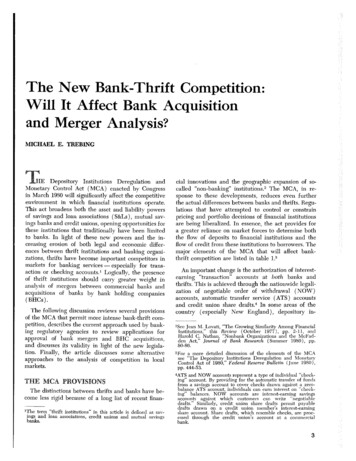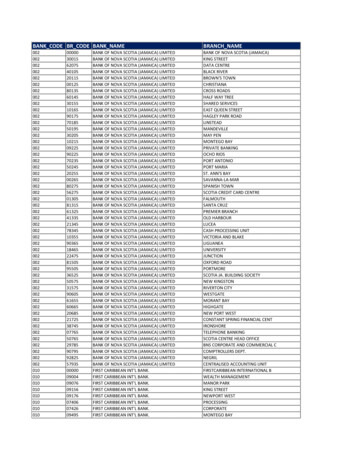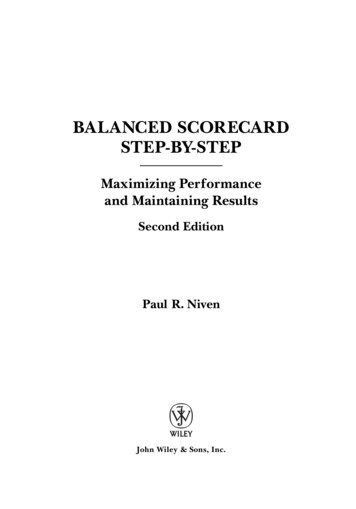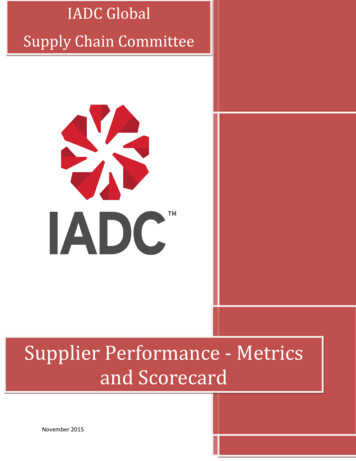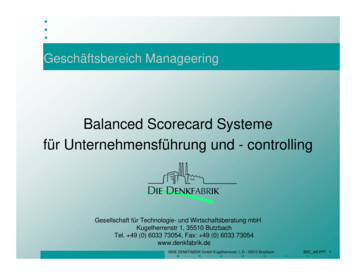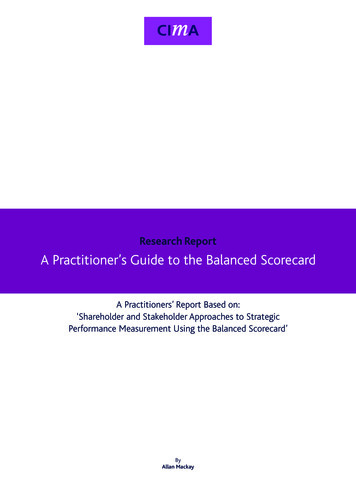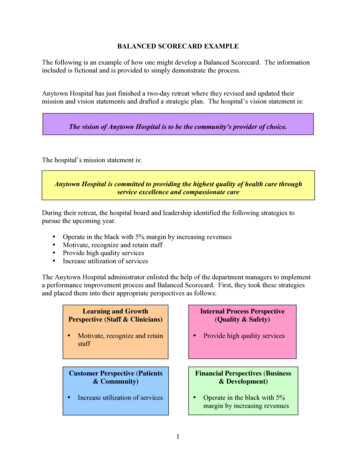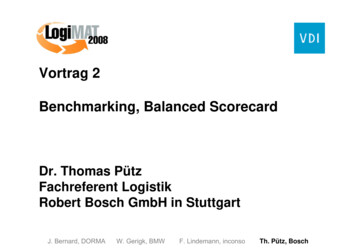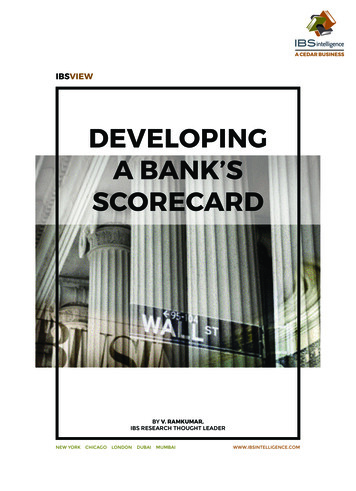
Transcription
gIBSVIEWDEVELOPINGA BANK’SSCORECARDBY V. RAMKUMAR,IBS RESEARCH THOUGHT LEADERNEW M
gWHILE BANK PERFORMANCESTEND TO GET TYPICALLYMEASURED BY THE GROWTH OFASSET BOOK OR NET PROFIT, AHOLISTIC ASSESSMENT OF THEBANK'S PERFORMANCE NEEDS TOBE BASED ON MEASURING BOTHindustries, the challenges and nuancesthat are applicable to a bank can be quitedifferent. More specifically, the key focusareas that need to be borne in mind whiledeveloping a balanced scorecard for abank, through each of the four buildingblocks as defined above, could be quitedifferent from other industries, and needto be approached appropriately. Let usexplore these in greater depth.FINANCIAL AND NON-FINANCIALPERFORMANCE – WHICH IS THETRUE ESSENCE OF A BALANCEDSCORECARD.STEP 1: BUILDING THE STRATEGYMAP FOR THE BANKWhen banks tend to measure their“enterprise performance,” the discussiongenerally gets restricted to the financialperformance - the asset book or the netprofit, and in some cases, the branchnetwork. While these do reflect growth,they are more of a lag-indicator of howthe bank performed during the lastreporting period, and do not reflect thesustainability of the performance on anon-going basis.The strategy map, while establishingthe top 20–25 objectives across thefour perspectives, also has to drivethe collective views of a bank – acrossmultiple facets and business divisions.At the same time, the map needs todistinctly reflect the bank’s priorities– both short-term and long-term. Thebiggest challenge is in building thisbalance.Considering that the ultimate purposeof the strategy is to drive enterpriseperformance, the balanced scorecarddesigned for a bank also needs to drawa balance between the financial andnon-financial objectives across all fourperspectives – financial, customer,process, and learning & growth.FINANCIAL: Even while the bank tends toimprove on its returns to shareholders, it isimperative to determine if the asset bookWHILE THE STEPS TO BUILD AThe four key building blocks for aneffective balanced scorecard in anyindustry would typically consist ofdeveloping the strategy map, definingthe right measures, aligning key initiativesSCORECARD ARE SIMILAR ACROSSINDUSTRIES, THE CHALLENGESTHAT ARE APPLICABLE TO A BANKwith the objectives, and assigning theright ownership. While the steps to buildthe scorecard are quite similar acrossCAN BE QUITE DIFFERENT.2IBSVIEW
gshould grow faster than the margins, orvice versa. A good strategy map alwayshelps define what would be the primaryfinancial objective for the bank, alsodefined as “F1.” The financial objectivesshould well define the revenue drivers,cost strategy, asset book strategy, andrisk management strategy.also set the right priorities for thechannels – an area that is increasinglybecoming important, especially when welive in an era of mobility and anywhere,anytime banking!LEARNING&GROWTH:Astheperspective that helps define theorganization’sobjectivestowardhuman competencies, technologicalCUSTOMER: With increased proliferationof differentiated segments, clarity onthe segment needs and defining theproposition for the target segment isimportant in the strategy map. The valueproposition essentially includes theproduct and service attributes, imageof the bank, and relationship quality. Itis critical to recognize the difference inapproach for the corporate, commercial,business, and the retail bankingsegments, when one goes about definingthe customer objectives.infrastructure, and the climate for action,it pretty much serves as the foundationlayer, and the organizational philosophyand its priorities. Being a customerservice-driven culture could be quite adifferent ball game than being a processor performance-centric culture. It is notabout what is right but about what is thehigher priority for the bank at that pointof time, and making that well defined.STEP 2: DEFINING THE RIGHTMEASURESPROCESS: From the point of identifyingthe customers’ needs to the point ofhaving the needs fully satisfied, theprocess framework of the bank needsto excel in the areas of innovation,operational excellence, and delivery ofservice quality. Continuous improvementto internal processes serves as thebackbone for delivering customerMeasurement tends to be the key to thescience of management. Having set thetop 20–25 objectives that constitute thecockpit view across four perspectives,it becomes imperative to define themeasures that best articulate theobjectives. Unless the objectives canbe measured, they cannot be managed.expectations. Not only should the processperspective focus on the products andservices for the customer, but it shouldPeople respond to what is inspected,not what is expected, and thereforemeasures drive organizational behavior,3IBSVIEW
gand help test the bank’s progress inachieving the strategic objectives.A select set of measures may be definedto be “break-through” targets, whichhelp in aspirational growth or quality.I know a CEO of a large retail bank,who is famously quoted by his teamfor walking into the planning session,writing a number on the whiteboard thatis way beyond what has been plannedby the team, and walking out withoututtering a word, but with an aspirationalmessage well delivered. Well, that isa breakthrough target that his team isexpected to deliver, no questions asked!So, what is different about the measuresthat need to be defined for a bank? It isall about selecting the right measuresthat help calibrate between lead and lagfactors, and a mix of ratios, monetaryvalues, and survey results. Typicalexamples of measures applicable in thebanking context include the following: Financialperspective:Typicalfinancial measures include ROE, ROA,asset book (corporate, commercial,business banking, retail), fee income,cost of funds, cost efficiency, assetutilization, and NPL%.STEP 3: ALIGNING KEYINITIATIVESWhile objectives help articulate thedestination, the approach to reach themstill depends on successfully deliveringthe right set of initiatives. Unless the rightinitiatives are defined and prioritizedappropriately, it is quite hard to achievethe measures set for each objective,however straightforward they may be.Customerperspective:Thecustomer related measures generallyincludecustomeracquisition,channel transaction mix, cross-sellpercentage,products/customer,customer satisfaction index, andcustomer attrition. Product features,image, and relationship strengthare key measures for a successfulcustomer and product strategy.Initiatives are means to deliver theend, which are the objectives. It is notuncommon to see banks mixing upinitiatives with objectives. For instance,a Lean-Six Sigma business process reengineering exercise is not an objectivebut an initiative that will help address afinancial or process objective, just as acore banking platform transformationwill help with a learning & growth Process perspective: Since this isreflective of the efficiency andproductivity, the typical measuresinclude operating cost, processSLA, branch transaction cost, andalternativechannelpenetration.Compliance is also measured by auditratings. IT IS ALL ABOUT SELECTING THELearning & growth perspective:Measurement of training days/employee, percentage of variableRIGHT MEASURES THAT izationalmeasures.Technologyrelatedmeasures include key milestones oftechnological initiatives and qualityof MIS.CALIBRATE BETWEEN LEAD & LAGFACTORS, AND A MIX OF RATIOS,MONETARY VALUES, AND SURVEYRESULTS.Tightly linked with the choice ofmeasures is the process of defining thetargets. Targets need to be defined as amix of easy, realistic, and stretch targets.4IBSVIEW
gILLUSTRATIVE BANK BALANCED SCORECARD3. Process enhancement: Activity basedcosting, Lean Six Sigma processenhancement, process centralization,process and technology outsourcing.objective, or a rebranding initiative willhelp address a customer objective.Interestingly, the process of identifyingthe initiative and mapping it to theobjective has a consistent pattern thatwe have observed across multiple bankswhere Cedar has helped in developingthe scorecard. Some of the mostcommon initiatives that are important fordelivering the strategic objectives are asfollows:1.4. Organization and human benchmarking&realignment, ESOP program designand rollout, training and development,employee engagement, performancemanagement system design.Financial and cost efficiency: Typicalinitiativesincludenewmarketand branch expansion, fee incomeimprovement, asset mix realignment,risk management, and cost reductionexercises.5. nrollout – CRM, loan origination,treasury, ALM & risk, transactionbanking system, data warehousing,business intelligence, HRMS, andenterprise GL.2. Products and channels: Marketresearch & assessment, new productdevelopment, alternative channeldesign and migration, building loyaltyprogram, realigning branch locations,fees and charges realignment.STEP 4: ASSIGNING THE RIGHTOWNERSHIPWhile5IBSVIEWthisisgenerallyquitea
gstraightforward activity, there is ascience behind assignment of theright ownership to every objective. Nomatter how tall the objective is and howeffective the measure is, an objectivethat is not owned will ultimately be anorphaned objective. Even while thereare differences about the owner for theobjective, it is important to recognizethat the custodian of the “data” thatprovides the status of the measure neednot be the owner of the objective.measure (IPM) as well. This also helpsto build the linkage between theenterprise and individual performancemeasurement.The value of any measurement tool is asgood as its usage. The key to successfulleverage of a balanced scorecard liesin making it an integral part of theday-to-day business-as-usual. Whenthe monthly meeting of the CEO isbased on the performance as indicatedby the measures of the 20–25 strategicobjectives, not only does it bring in theeffectiveness of focus to the conversation,but it also enables a deeper dive into thenature of the underlying issue that hadpotentially resulted in the performance orthe lack of it. Aligning initiatives with theobjectives and building the ownershiptherefore becomes imperative. After all,what cannot be measured cannot bemanaged too!This is a subtle but important fact to bekept in mind. There are four simple rulesto be borne in mind when objectives areassigned to owners while designing andimplementing a scorecard:1.Define primary ownership: The F1 orthe primary financial objective shouldbe the responsibility directly ownedby the CEO. If it were a cascadedscorecard of a business unit suchas corporate or retail, the unit headwould be the owner for the primaryfinancial objective.About IBS IntelligenceEstablished in 1991, IBS Intelligence isthe definitive source of independentnews, analysis & research relatingto global financial technologymarkets. IBS has an integratedoffering including a comprehensiveresearch portfolio, and a range ofvalue added services. Its iconicmonthly publication – IBS Journal– is recognized worldwide. IBSIntelligence is now a division of CedarManagement Consulting InternationalLLC, a leading global managementand technology consulting firm. Thefirm, with its research and consultingexpertise has worked with over 1000clients globally.2. Ensure singularity of ownership: It is apreferred practice to have ownershipof an objective assigned to oneowner. Joint ownership with morethan one owner should ideally be anexception than being the rule.3. Align objective-initiative ownership:Where the initiative is directly linkedto an objective one-to-one, theownership of both initiative andobjective is best assigned to the sameindividual.4. Alignenterprise-individualperformance measurement: Lastly,the objectives that have the directownership from an individual are bestlinked to the individual performanceFor more information, please visitwww.ibsintelligence.com or email usat info@ibsintelligence.com6IBSVIEW
of MIS. Tightly linked with the choice of measures is the process of defining the targets. Targets need to be defined as a mix of easy, realistic, and stretch targets. A select set of measures may be defined to be “break-through” targets, which help in aspirational growth or quality. I know a CEO of a large retail bank, who is famously quoted by his team for walking into the planning .



